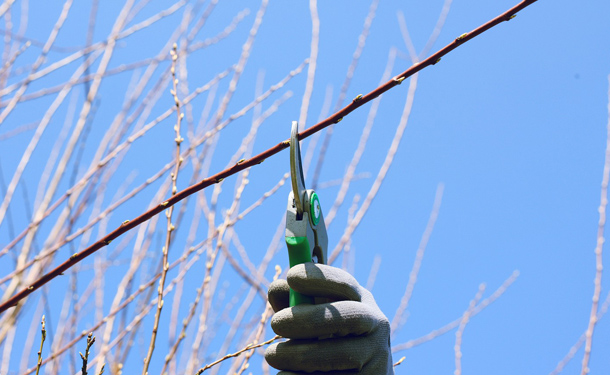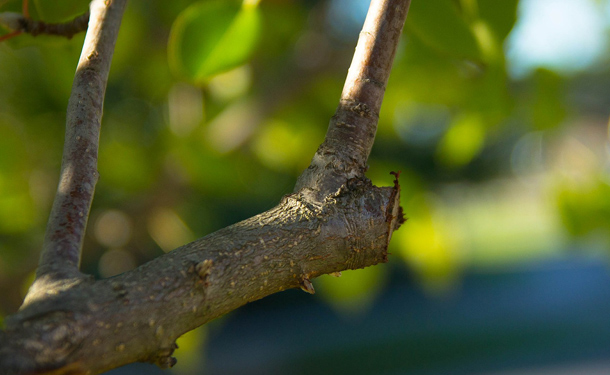Tree trimming and tree pruning are relatively easy tasks if you know what to look for, how to make proper cuts, and when you should call a professional tree service.

The height, shape, and health of your trees can all be determined by the way you trim and prune them. Specifically, your tree’s health is directly affected by this process. A properly trimmed and pruned tree will thrive in its environment, while a poorly trimmed tree becomes more susceptible to disease, infestation, and fungi for the remainder of its life.
We at The Tree Care Guide have compiled a short, easy to understand list of tips to help you get this job done properly and safely.
Have A Good Reason to Prune
When it comes to pruning your trees, you should have a clear and specific objective. Just because it’s pruning season does not mean that you should just go cut your trees.
Watch this video about tree pruning tips:
Most often we prune for these three principle reasons: health, safety, or aesthetics.
Health – When a tree falls victim to an infestation, fungal infection, or dieback, the tree can sometimes be saved by pruning away the infected areas. There is no wrong time for this type of pruning, as the greater stress on the tree would be to ignore and leave it.
Whereas pruning can be a response to danger, when performed proactively it can promote and improve a tree’s health. Tree crown thinning stimulates and benefits a tree’s health by allowing more air and sunlight to reach the inner leaves and branches.
Safety – Crossed branches that rub up against or bump each other in the wind should be trimmed back. This will avoid scaring, or one of them knocking the other to the ground, creating a serious hazard.
Another safety hazard may be caused by dead, brittle, or broken branches haphazardly dropping from the tree.
Another safety concern warranting pruning is when branches obstruct your line of sight of the sidewalk or road ahead. These limbs and branches should be trimmed back, cut off, or have the canopy be raised.
Lastly, trees that have grown too close to power lines are a hazard and major cause of damage in storms or severe weather. These situations should be dealt with only by a professional tree service or the local power company.
Aesthetics – The look of a tree can be greatly enhanced and influenced through regular pruning. Be cautious though, trying to create a topiary could influence you to trim too deep, seriously damaging the tree.
Tree Pruning – Raising the Crown
Crown raising is the pruning and removal of the lowest branches of a tree.
- Younger trees respond well to this action by developing more growth in the upper branches.
- For older trees, be cautious. Their crown branches will be much larger, leaving larger wounds and greater potential for infection or infestation.
Raising the crown of a tree is generally performed to provide clearance for pedestrians, vehicles, or improving the line of sight for roadways and sidewalks.
Tree Pruning – Thinning the Crown
Crown thinning is the selective and careful removal of branches within the crown. This option provides great relief to trees that continuously sustain strong wind or have to carry the weight of accumulated snow and ice.
- Prune away branches that cross or are in contact with other branches.
- Branches should be evenly spaced, creating both symmetry and balance.
- Improper or over thinning can leave your tree susceptible to decay and disease.
Note – Extensive crown thinning should be performed over a series of years. Removing more than a quarter of the crown at once may cripple or kill the tree.
Tree Pruning – Cleaning the Crown
Cleaning the crown is the process of removing the dead or dying branches, which is a proactive tree care approach that often produces a healthier and longer lasting tree.
Crown cleaning removes unnecessary weight, stops the spread of decay, and drastically reduces the danger of falling branches.
- If more than half of the foliage of a branch is to be removed, remove the entire branch.
- If you are considering removing more than a fourth of the crown due to its damage, contact a tree professional to assess the situation; there may be an underlying issue affecting the tree’s health.
Tree Pruning – Height Reduction
Properly reducing the height of a tree requires precision pruning. Irreparable damage may be done to the tree if performed improperly.
- Know the species and growth pattern of your tree. Depending on the species, height reduction may lead to serious damage and the death of the tree.
- Avoid “topping” the tree. Topping or cutting broadly across the top and through the main trunk can lead to the decline of the tree’s health and eventual death. In such a situation, where the height is problematic, consider removing or relocating the tree.
- When it comes to height reduction, seek the assistance of a trained arborist or tree care professional. More often than not, this procedure (done incorrectly) will cause more problems than solutions.
Tree Pruning – Cutting Techniques
Make sure that your tools are sharp and that you are taking the proper safety precautions when using them.
- Your cuts should be clean.
- Avoid using tree wound paint to cover cuts. Typically the tree will react to the cut by closing it’s wound off and healing itself.
- For larger branches that have formed a “branch bark ridge” and “collar”, cut just outside the bark ridge and collar without leaving a protruding stub.
- If the limb or branch is smaller and has not formed a collar, cut close to the base.
- For shortening a small branch, locate a lateral bud or an already developed lateral branch that is growing in an outward direction. Make a clean cut at a slight angle with the base of the cut a quarter of an inch past the bud or branch.

If the job is questionable, extensive, or the tree is large, it should more than likely be performed by a professional tree service.
Pruning Safety and Common Sense
Now that you have a better idea of the work to be accomplished, have at it and keep these safety points in mind:
- Always use protective eyewear, gloves, and sturdy clothing.
- Make sure there is nothing below the crown, even the lightest branches can hurt hey person or a pet.
- Never make a cut that leaves you in the “drop zone”.
- Don’t make cuts that you are unsure about.
- If the job is more extensive than originally planned, or risks compromising the stability and health of the tree, call a tree service for help.
Watch this video to see a large tree being properly and safely pruned.
Tree Pruning
Tree pruning is a technical approach to cutting a tree to shape it, provide clearance, or remove dead, disease, and damaged branches.
Always begin your pruning project with a clear vision of the results you desire, make proper cuts, and know when to stop.
When performed properly, pruning can improve the health and appearance of a tree. Conversely, an improper pruning job can damage or kill an otherwise healthy and thriving tree.